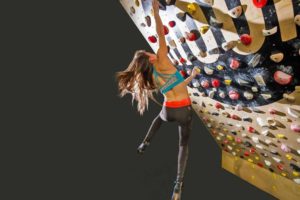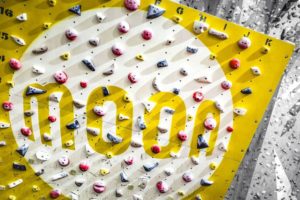Climbing boards can effectively help climbers to boost their strength, technique, and overall climbing performance.

A study published in Scientific Reports concludes that an 8-week training with climbing training boards has significantly improved the overall grip strength of climbers as compared to training without boards.
With various options available in the market, it’s difficult to opt for the best one.
The two renowned boards known for their effectiveness in uplifting overall climbing skills are the kilter board and moon board.
They both offer different features which set them apart from each other.
Understanding these factors can help climbers make informed choices based on their preferences, needs, and training goals.
This article will provide a detailed comparison between the Kilter and Moon boards.
We will investigate various important considerations for climbers while choosing a climbing training board and provide a complete comparison for selecting the ideal one for you.
Kilter Board vs. Moon Board – Full Comparison
Climbing training boards, or hang boards, are crucial tools for climbers of all levels to uplift their climbing skills.
These boards help climbers strengthen their finger and upper body muscles, improve their grips, and boost their overall climbing.
Thus, climbers must consider various factors when choosing a climbing training board.
Below is a detailed comparison of two well-known climbing training boards: the Kilter Board and the Moon Board.
Kilter Boards vs. Moon Boards – A Brief Introduction
Though the Moon Boards we know today were made official in 2016, they started much earlier.
In the 1980s, a frustrated rock climber from England, Ben Moon, made his wood climbing board due to lacking training facilities.
This space gained popularity among climbers as THE SCHOOL ROOM. Later on, this idea became the reason for Moon boards.
On the other hand, Kilter Boards were designed in the late 1990s by Ian Powell and Jackie Hueftle.
These boards feature aesthetic designs and fresh technology to help climbers boost their skills.
Design and Features
Climbing training boards are available in various designs and cater to specific training needs.
Choose what suits you the most and aligns with your climbing needs, such as bouldering or sports climbing.
Kilter boards are available in various sizes, but their standard size measures around 8 feet wide and 12 feet tall.
Their compact design allows their installation in various indoor spaces.
Contrary to this, Moon boards come in a standard size of 8 feet wide and 12 feet tall.
Their size ensures uniformity across different installations worldwide and provides a standardized training platform.
Holds size and Variety
A good climbing board should provide a range of holds to offer progressive training and accommodate all difficulty levels.
Thus, ensuring your board is offering various hold options is important.
The Kilter board offers various holds, including slopers, crimps, pockets, and jugs.
The holds are placed strategically over the board to provide a more challenging experience for climbers of all levels.
Additionally, holds mimic outdoor climbing grips to develop specific techniques.
While The Moon boards offer a fixed set of holds strategically placed.
These holds mimic the 1980s Moon holds designed by Ben Moon but are more developed and integrated with modern technology.
Comfort and Ergonomics
Your comfort is a vital aspect to consider while choosing a climbing board. Look for smooth texture options to minimize abrasions and prevent any potential injuries.
Additionally, ensure that the board offers a good grip and stability while mounted to a wall or doorframe.
Both Kilter and Moon Boards offer rounded edges, grip-enhancing textures, and secure holds to provide a comfortable training experience.
The round edges prevent potential injuries, and textured surfaces promote more stability and grip.
These features promote climbers’ confidence and focus on their training while ensuring secure holds.
Suitability for Different Skills Levels

The Moon and Kilter boards engage climbers of all skill levels and provide opportunities to advance their climbing skills.
In Kilter board, the range of holds allows the climber to choose climbing difficulty depending on their skills.
Beginners can start with larger and easy hold options, while advanced climbers can opt for more demanding holds.
Contrary to this, the Moon board features only standardized hold options.
However, in Moon boards, various route options help climbers to decide difficulty levels according to their climbing skills.
Additionally, the Kilter boards have soft holds, adjustability options, and an effective lighting system.
Compared to this, Moon Boards has no adjustability options, no modern lighting systems, and the holds are also rough.
Portability and Ease of Installation
Depending on mounting options, two common types of climbing training boards are available in the market.
One can be easily mounted and portable, while the others require a permanent installation and offer different difficulty levels.
Now it’s your need to determine which design suits you the best.
Considering your space options, portability, and ease of installation of the climbing training board is important before buying.
Kilter Boards have adjustable angles, thus offering more portability options than Moon boards.
Kilter board models that can be easily dismantled are recommended for climbers with travel needs.
Talking about ease of installation, this mostly depends on the specific type of climbing board.
For example, the Doorframe-mounted boards have an easy installation process for both Kilter and Moon boards as compared to other models like wall-mounted boards.
Durability and Quality
Durability and quality are basics for any purchase; the same goes for climbing training boards.
Manufacturing materials and the reputation of brands are important factors when considering the quality and durability of climbing boards.
Consider boards made with high-quality material and use previous customer feedback to ensure brand quality and reputation.
The Kilter and Moon Boards have a good reputation among the climber community for authentic products.
However, both brands manufacture different boards with different materials; thus, their durability and quality can vary according to their type and model.
Training Tools and Accessories
Additional training resources and accessories can be immensely helpful for climbers to track their performance and progress in their climbing skills.
The training guides that come along the boards also help beginners to start their climbing journey effectively.
In the case of Kilter boards, their smartphone app offers an interactive training experience.
This online platform provides access to training programs, workouts, and climbing challenges.
Furthermore, Kilter board has a community of experienced climbers who share their training routines, route setups, and other valuable experiences.
This act as inspiration for newbies and provides learning opportunities.
On the other hand, The Moon Board app is the same as Kilter’s but advanced in some aspects.
The performance tracking tools allow the climber to try various boulder problems and record their achievements.
Additionally, Moon boards have had a community engagement commonly known as The School Room since its inception.
Now this community is developed and has worldwide engagement.
This offers opportunities to share experiences, receive feedback, and connect with like-minded climbers.
Finger Strength Training – Kilter Board vs. Moon Board

Finger strength training is a crucial part of climbing training.
A study published in the Frontiers concludes that 10 weeks of climbing board training was highly effective for finger strength as compared to regular climbing training.
Kilter boards’ revolutionary lightning system and monochrome holds attract climbers like magnets.
They are more ergonomic than Moon boards and are designed to keep comfort in mind.
Although many new climbers praise these holds, experienced climbers find them less effective for finger strength training.
Thus, Kilters is introducing a new set of holds by considering this limitation.
Holds Visibility
The visibility of holds at different angles is an issue faced by various climbers. In Kilter, the board holds are manufactured from a semi-transparent base.
This means when lightening up, these holds are visible from every angle. Contrary to this, in Moon boards, lights are in the base of each hold, which makes it difficult to notice.
Additionally, though the lightning system in Kilter’s is effective, its visibility decreases in the daytime, especially when holds are covered with chalk powder.
Price Range
Climbing training boards are available in diverse price ranges. Consider what values different boards are providing in your budget.
While investing in a quality product is important, remember that a higher price doesn’t always guarantee a better training experience.
Kilter boards offer advanced features and versatility making them expensive compared to other options.
This makes it difficult for climbers on a budget to make such a significant investment.
Regarding cost, Moon boards are quite more affordable than other options. They provide a quality climbing experience within the budget.
The Bottom Line
After a detailed analysis of both boards, the Moon and Kilter, it’s evident that both hold offer versatile benefits and features for climbers.
The decision of which board is good for you ultimately depends on individual preference, budget, available space, and training goals.
Thus, climbers should first consider their priorities. Kilter Board may be a good choice if versatility, interactive training, and diversity are important.
In contrast, if standardized training, global community accessibility, and cost-effectiveness are priorities, the Moon Board could be suitable.
Whatever your choice, the Kilter and the Moon Board offer valuable tools to enhance climbing skills, improve strength, and boost overall performance.

When I was in high school, I was the best at running. Running for me is not a trend, this is my whole life. I jog every morning, without exceptions: I don’t skip mornings on vacations or business trips. My friends are also sports fans: I went to my best friend’s yoga class for the first time about three years ago.
Since then, I’ve been practicing regularly, and we have also made several yoga trips to India. For my last birthday, I got a skateboard as a present from her. Now we’re both taking personal classes with a coach, and it’s 100% fun!





